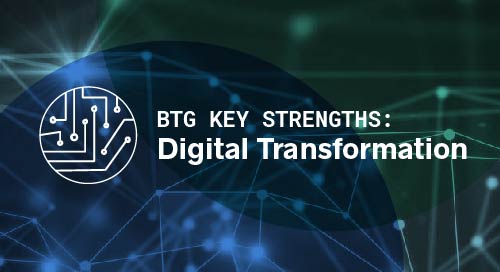Whether dealing with disruption or predicting which way the wind will blow next in a mercurial market, speed and flexibility are often the deciding factors for success. This was proven time and again during the pandemic, when companies with cloud-based Enterprise Resource Planning (ERP) solutions were able to move more nimbly than those with disparate systems.
By centralizing and integrating business functions, ERP software aids transparency and communication, allowing organizations to switch gears quickly while remaining aligned. All data is stored and organized within a central database, allowing for rapid analysis and detailed reporting. As a result, companies can get a clearer look into the health of their organization and identify opportunities for improving efficiency, innovation, and cost savings.
Alternatives certainly exist—e.g. some organizations cobble together software solutions to meet specific business needs, while others outsource certain processes to third-party providers. But differences in data models can make it difficult to get a reliable, holistic view of the organization, and managing and updating multiple systems can be a drain on IT resources. Moreover, while discrete software solutions may seem more cost-effective at the outset, their total cost of ownership is likely to exceed the upfront costs of an ERP, and implementing individual solutions makes it exceedingly difficult to realize the savings that a fully optimized ERP system offers:
- Less wasted time spent searching and integrating data from fragmented systems
- Quicker decision-making, because users at every level have access to and are working off of the same information at all times
- Simplified, and frequently automated, reporting, granting executives a clear view of the organization’s operations on an up-to-the-minute basis.
- Valuable, timely insights on customer trends from integrated CRM systems, enabling the company to pivot, build, or deprecate initiatives as necessary
- Compliance management to ensure adherence to industry-specific regulations
- Forecasting tools to help with everything from planning production schedules and optimizing inventory levels to predicting future cash flow and assessing future hiring needs
So if the benefits are this clear—and justify a business case for the upfront costs—why are some companies failing to successfully implement an ERP software transformation?
Why so many ERP transformations fail
When ERP software transformations fail, it’s usually because they weren’t set up for success from the start. Too often, those leading the transformation fail to see that an ERP implementation is not an IT project: It’s a business-led project that requires active engagement with stakeholders across the organization. IT can assist with system selection, data migration, and user training, but before any of those activities can even begin, a robust, strategic framework for the transformation must be put in place.
A 2019 report from McKinsey found that “three-fourths of ERP transformation projects fail to stay on schedule or within budget, and two-thirds have a negative return on investment.” The factors behind these staggering statistics boiled down to a lack of adequate program management.
A successful ERP implementation is guided by strong program managers who secure the support of the C-suite and ensure alignment with the organization’s strategic objectives. In doing so, they’ll not only guarantee the initiative has sufficient resources and funding; they’ll also smooth the path for effective change management.
As a centralized, comprehensive system, ERP software has an impact on virtually every role in an organization. Users must be fully prepared for transformation and given effective training, or they could struggle to adapt. Even more likely, they might resist changes outright: Deloitte found that resistance to change is the top barrier to a successful ERP transformation journey. By making sure everyone is involved in the transformation, program managers can bolster support across the enterprise and speed ERP software adoption.
Alignment is also the key to preventing the new system from becoming over-complicated with extraneous customization. Given how flexible and precisely tailored ERP software can be, it’s easy to imagine how companies could get carried away. But every additional feature brings with it down-the-road updates and additional maintenance, so it’s important for program managers to earmark only those that are truly essential for implementation.
A unique challenge for SAP clients
For companies currently running on SAP software, the clock is ticking on ERP transformation especially loudly. Though SAP agreed to extend support for Business Suite 7 through 2030 (at the latest), some businesses are finding that timeline daunting as the transition to S/4 HANA gathers pace.
One of the world’s largest pharmaceutical companies has already invested $2 billion into upgrading, but their program—like many—is taking four to five years to build out. They might make it in just under the wire, but many others won’t. There’s a distinct lack of qualified ERP implementation consultants in the market right now, leading some to contend that the extension doesn’t solve anything, it just delays the problem:
“There simply aren’t the skills or resources available to migrate everyone by that deadline,” Darren Roos, CEO of enterprise software specialist IFS says.
What’s more, when disruptive forces—from cyberattacks to natural disasters—loom large, those with outdated ERP systems risk potentially devastating downtime. “Downtime costs organizations around $300,000 per hour due to productivity losses and catch-up time,” Forbes Technology Council member Kevin Beasley reports. “While it can’t always be measured, the reputational damage following downtime can also be difficult to recover from.”
SAP is shy on specialists, and resources from the Big 4 consulting firms are already committed to ongoing transformations. Even Tier 2 suppliers are sold out. Between companies looking to move from point solutions to an ERP system, and SAP ERP-tied organizations that desperately need to migrate to next-gen software, there’s an overwhelming demand to get started immediately.
But how do you get started when there’s no one left to help?
ERP expertise, on demand
Traditional consultancies might be tight on ERP support, but fortunately for businesses looking to implement on-premise or cloud-based ERP, there’s plenty of high-quality independent talent out there. And much like the nimbleness and speed offered by cloud-based ERP software, BTG’s unique platform offers clients centralized access to these types of specialized resources.
When the talent market is tight, BTG’s experienced on-demand executives can “chalk the field” and/or “move the ball downfield” as EVP, Chief Innovation Officer at BTG Sandra Pinnavaia puts it. Here are just a few examples of how our expert ERP implementation consultants have helped major companies keep their ERP goals on track:
Getting back on Track with SAP Integration
As mentioned earlier, SAP integration is a particularly timely matter, so when a global healthcare company was running two weeks behind on its go-live, the client needed a plan for recovery—fast. BTG provided an executive with experience in ERP migrations, specifically SAP and Electronic Warehouse Management (EWM).
Drawing on their background in supply chain transformation, the talent was able to define the path to recovery, along with a system sustainability assessment to prevent workstream issues with future integrations.
Leading ERP Work from a Business Process Perspective
Sometimes, the plan is already in place, but the business lacks the resources to execute. This was the case when the VP of strategy at a food and beverage giant commissioned an ERP redesign to streamline the company’s heavily customized system and critical processes. With no one in-house to lead the work, the client turned to BTG for someone who could not just advise but execute.
BTG brought in a business process transformation expert who had led multiple ERP implementations at IBM’s SAP practice. He worked with the client’s technical lead to drive “as is” documentation and spearhead early “to be” design efforts. Throughout the process, he helped spot potential issues and developed plans to rectify them.
After he painstakingly standardized and integrated master data into his designs, he created a Center of Excellence for master data management. The results were so impressive, the company decided to roll his designs out to other business units across the enterprise.
Managing Multiple Global Transformations
When things become productively complicated—as they did for a Fortune 1000 retailer that had initiated a number of global transformations with multiple consulting firms—organization becomes a top priority.
The retailer’s CEO approached BTG for an Organizational Change expert who could quickly coordinate multiple vendors and complex workstreams while ensuring all of the transformations were completed smoothly. We connected him with a former Partner at Accenture who had decades of experience that gave him deep insight into the client’s issues.
Our talent helped harmonize external workflows while ensuring timely completion of deliverables. When it became clear that additional change management capabilities were needed in order to build on his success, he stayed on to help establish a permanent Project Management Office.
Whether you’re just getting started or you’re midway through a transformation and the ERP consultant shortage has stopped you in your tracks, BTG offers limitless access to the talent and skills you need. We carefully curate and vet our talent for the highest caliber qualifications, yielding tens of thousands of independent experts with resumes that include Big 4 consulting firms, boutique and specialty firms, and Fortune 50’s most admired companies.
Let us help you on your ERP journey—find the expertise you need today.
GET THE SKILLS YOU NEED
Thousands of independent consultants, subject matter experts, project managers, and interim executives are ready to help address your biggest business opportunities.
About the Author
More Content by Emily Slayton























